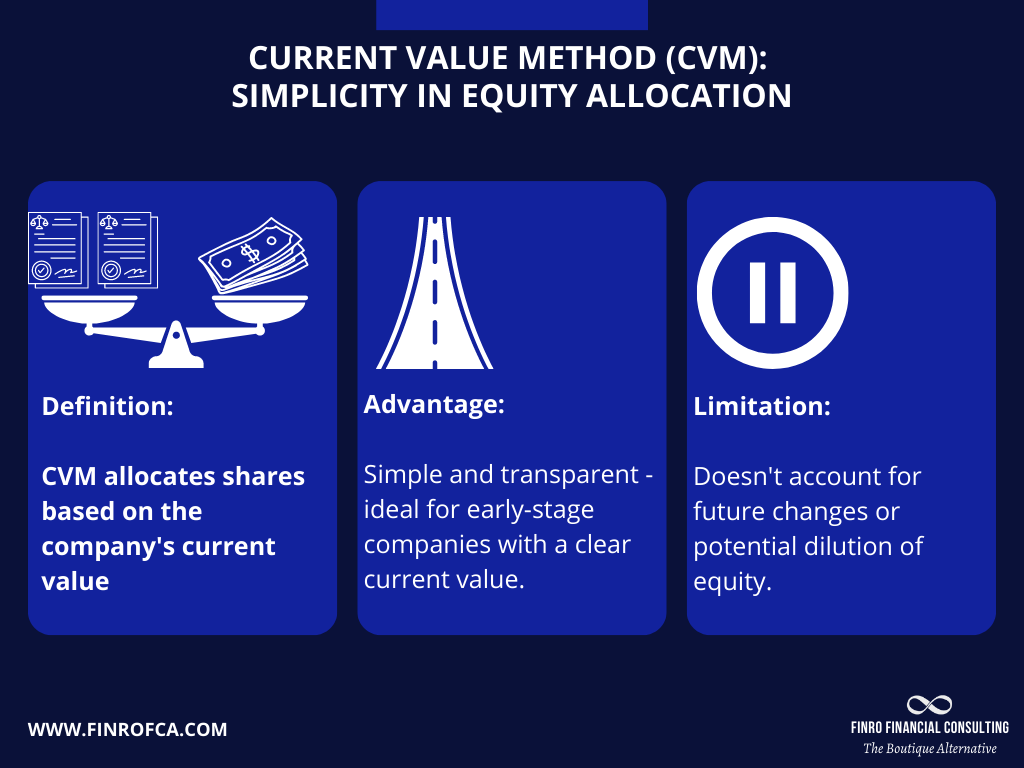What is Equity Allocation?
By Lior Ronen | Founder, Finro Financial Consulting
Equity allocation is crucial in every business, but even more crucial in VC-backed startups.
Why?
Because there is a lot of equity to allocate to many different parties.
Equity allocation is how a company divides its ownership stakes, often represented by shares or stock, among its participants - founders, investors, and employees.
The layout of this ownership distribution is typically documented in what's known as a capitalization table, or cap table for short. The cap table is the key to how a company should’s dividends, funds from liquidity events, and voting rights.
Moreover, how equity is allocated plays a crucial role in attracting and retaining top talent and securing the necessary capital for the company's growth.
A thoughtful and equitable allocation of shares, effectively reflected in the cap table, can significantly contribute to a company's success.
The calculation method and how to distribute the funds and rights to the stakeholders is done with an equity allocation process.
In this article, we’ll explain what an equity allocation is, what are the primary equity allocaiton methods and how to pick the method for your case.
Equity allocation in startups involves dividing ownership stakes among founders, investors, and employees, crucial for sharing profits, losses, and decision-making power. This process is documented in a capitalization table, detailing who owns what part of the company.
There are three primary methods: Current Value Method (CVM), which is straightforward but doesn't account for future value changes; Probability-Weighted Expected Return Method (PWERM), considering potential future scenarios; and Option Pricing Method (OPM), using financial models for complex equity structures.
The choice of method varies based on the company's stage, future prospects, and equity structure complexity.
- Understanding the Cap Table.
- Overview of the Three Primary Allocation Methods
- The Current Value Method (CVM)
- The Probability-Weighted Expected Return Method (PWERM)
- The Option Pricing Method (OPM)
- Choosing the Right Equity Allocation Method for Your Company
- Conclusion: The Art and Science of Equity Allocation
Section 1: Understanding the Cap Table
Before diving into the equity allocation methods, let's first understand the term "cap table".
A capitalization table, often referred to as a cap table, is essentially a ledger showing a company's equity ownership. Simply put, it's like a list that tells us who owns what part of the company.
This includes all the stakeholders – the founders, investors, and employees who might own shares through options.
Importance and Role of a cap table
Cap tables play a pivotal role in any business as they provide a snapshot of the company's equity distribution and the potential dilution of ownership in future funding rounds.
They help the stakeholders keep track of who owns what, how much future ownership might look like under various scenarios, and how much each stake might be worth.
In essence, cap tables can influence decisions related to fundraising, equity grants, and even company sales.
Composition of a cap table
A standard cap table typically includes the names of the equity holders, the type of equity they hold (like common stock, preferred stock, options, warrants, etc.), the number of shares they own, the percentage of total ownership they represent, and the price they paid for the shares.
Dynamics of a cap table
It's important to note that a cap table is not static.
It evolves over time as the company grows, raises more funds, or grants more equity to its employees.
So, regular updating and management of the cap table are key to accurately reflect the current state of the company's equity structure.
Having laid down the concept of a cap table, we are now ready to delve into the various methods that are commonly used to determine how the equity of a company is allocated, all of which would be reflected in a company's cap table.
These are the Current Value Method (CVM), the Probability-Weighted Expected Return Method (PWERM), and the Option Pricing Method (OPM).
Section 2: Overview of the Three Primary Allocation Methods
Building on our understanding of cap tables, let's dive into the heart of equity allocation – the methods used to decide how ownership is divided.
Three primary allocation methods are widely adopted in business environments:
The Current Value Method (CVM): Also known as the "waterfall method," CVM uses the current or present value of the company to allocate shares to stakeholders. It's a relatively straightforward method but may fall short when future changes in the company's value or potential dilution of equity need to be considered. We will explore CVM in detail in the next section.
The Probability-Weighted Expected Return Method (PWERM): PWERM, on the other hand, addresses some of the limitations of CVM by incorporating future potential scenarios. It's a bit more complex but provides a more nuanced view of equity allocation by considering future outcomes and their associated probabilities.
The Option Pricing Method (OPM): Finally, there's OPM, which combines aspects of the other two methods and utilizes option pricing models to assign a fair value to equity securities. It's particularly useful in scenarios involving multiple types of securities, such as preferred and common stock.
In the sections that follow, we'll dive deeper into each of these methods, beginning with the Current Value Method.
As we examine each approach, keep in mind how they interact with the cap table and affect its structure.
Section 3: The Current Value Method (CVM)
The Current Value Method (CVM), sometimes referred to as the "waterfall method," is one of the more straightforward ways to handle equity allocation. It looks at the present or "current" value of the company and allocates shares based on that valuation.
The first step in applying the CVM is to determine the current value of the company.
This is typically done by agreement between the founders or a third-party evaluation.
Once the company's value has been established, the next step is to distribute the shares to stakeholders according to their contributions.
If an investor contributes a certain amount of capital, they receive an equivalent percentage of the company's total value in shares.
Example:
For instance, if the current value of a company is determined to be $1 million and an investor contributes $200,000, the investor would receive a 20% stake in the company, reflecting their contribution to the overall value.
Advantages and Limitations of CVM:
CVM's major advantage lies in its simplicity and transparency. It provides a clear picture of equity distribution based on the current valuation.
However, its limitations also stem from this simplicity.
CVM does not account for future changes in the company's value or the potential dilution of equity in subsequent funding rounds.
This could lead to disagreements or discontent among stakeholders in the future if the company's value changes significantly.
In the next section, we'll look at another allocation method that addresses some of the limitations of CVM by considering potential future scenarios.
This method is known as the Probability-Weighted Expected Return Method (PWERM).
Section 4: The Probability-Weighted Expected Return Method (PWERM)
The Probability-Weighted Expected Return Method (PWERM) adds a layer of complexity to equity allocation by looking beyond the present and into potential future scenarios.
Unlike CVM, which is centered around present values, PWERM considers a range of possible exit scenarios for the company and their associated probabilities.
The process of PWERM begins by identifying potential future outcomes for the company.
These might include things like going public, being acquired, or continuing to operate as a private company.
Each outcome is then assigned a probability, reflecting the likelihood of that scenario occurring.
These probabilities are based on a combination of internal forecasts, market trends, and sector-specific data.
Once the scenarios and their probabilities have been established, the next step is to calculate the expected return for each stakeholder under each scenario.
These expected returns are then weighted based on the associated probabilities to determine the overall equity allocation.
Example:
For instance, if there are three potential scenarios with equal probabilities – going public, being acquired, or remaining private – the PWERM would calculate the expected return for each stakeholder under each of these scenarios, weight those returns based on the 1/3 probability, and sum them to get the overall equity allocation.
Advantages and Limitations of PWERM:
The strength of PWERM lies in its consideration of future potential scenarios, making it a more dynamic and forward-looking method of equity allocation.
However, its complexity also brings challenges. The method requires substantial data and market insight to accurately predict future scenarios and their probabilities.
Plus, the subjective nature of these predictions can lead to disagreements among stakeholders.
In the next section, we'll explore the final method, the Option Pricing Method (OPM), which combines elements of both CVM and PWERM and utilizes option pricing models to assign a fair value to different equity securities.
Section 5: The Option Pricing Method (OPM)
The Option Pricing Method (OPM) adds another layer of sophistication to the equity allocation process. Drawing from the world of finance, it utilizes option pricing models to assign a fair value to different equity securities, such as preferred and common stock.
OPM views each equity security as a call option on the total equity value of the company, with the exercise price equivalent to the payout or liquidation preference of that security.
It uses option pricing models, such as the Black-Scholes-Merton model, to calculate the fair value of these "options."
The allocation of equity then depends on these calculated fair values.
The higher the fair value of a security, the larger the proportion of equity assigned to the holder of that security.
Example:
For instance, if a company has both preferred and common stock, OPM would calculate the fair value of each using an option pricing model.
If the preferred stock had a higher fair value due to a liquidation preference, the holders of the preferred stock would receive a larger proportion of the company's equity.
Advantages and Limitations of OPM:
OPM's strength lies in its ability to accommodate complex equity structures with different types of securities.
It can provide a more nuanced and accurate picture of equity allocation in these scenarios.
However, its complexity can also be a drawback. It requires a thorough understanding of financial models and can be more difficult for stakeholders to understand and agree upon.
In the next section, we'll summarize these three methods and offer some guidance on how to choose between them based on the specifics of your company's situation.
| Current Value Method (CVM) | Probability-Weighted Expected Return Method (PWERM) | Option Pricing Method (OPM) | |
|---|---|---|---|
| Definition | Allocates shares based on the current value of the company | Considers a range of potential future outcomes and their associated probabilities to allocate shares | Utilizes option pricing models to assign a fair value to different equity securities and allocate shares |
| Advantages | Simple and transparent | Accounts for future potential scenarios; more dynamic and forward-looking | Accommodates complex equity structures with different types of securities; can provide a more nuanced picture of equity allocation |
| Limitations | Does not consider future changes or potential dilution of equity | Requires substantial data and market insight; predictions can lead to disagreements | Requires a thorough understanding of financial models; more difficult for stakeholders to understand and agree upon |
| Use Cases | Best for early-stage companies with a simple cap table and a clear current value | Suitable for companies with uncertain future prospects that may significantly impact their value | Ideal for companies with complex equity structures involving different types of securities |
Section 6: Choosing the Right Equity Allocation Method for Your Company
The Current Value Method (CVM), Probability-Weighted Expected Return Method (PWERM), and Option Pricing Method (OPM) each provide unique perspectives and advantages in equity allocation.
The choice between them depends on several factors, including the stage of your company, the complexity of your cap table, and the future prospects of your enterprise.
Considerations for Choosing the Right Method:
Company Stage: Early-stage companies with straightforward cap tables might find CVM most suitable due to its simplicity and transparency.
Future Prospects: If your company's future holds different potential scenarios that could significantly impact its value, PWERM's forward-looking approach could be beneficial.
Equity Structure Complexity: For companies with more complex equity structures, involving different types of securities, OPM's use of option pricing models provides a nuanced understanding of equity allocation.
Choosing the appropriate equity allocation method is not a decision to be made in isolation.
It requires collaboration between founders, stakeholders, and financial advisors.
Legal and tax implications should also be considered, and for that reason, consulting with legal and tax experts is crucial.
In conclusion, understanding equity allocation and the methods used to implement it is essential for any entrepreneur or business owner.
By carefully considering the specifics of your situation and leveraging the expertise of professionals in the field, you can make informed decisions that align with your company's best interests.
Section 7: Conclusion: The Art and Science of Equity Allocation
Equity allocation is both an art and a science.
It requires understanding complex financial concepts and methods, but also involves subjective decisions and predictions about the future.
The Current Value Method (CVM), Probability-Weighted Expected Return Method (PWERM), and Option Pricing Method (OPM) each offer unique approaches to tackle this challenging task.
But remember, no single method can provide a one-size-fits-all solution.
The choice between them must be tailored to the specific needs and circumstances of your company, reflecting its stage, future prospects, and complexity of equity structures.
Moreover, it's crucial to remember that choosing the appropriate equity allocation method is a collaborative process.
It necessitates cooperation between founders, stakeholders, and financial advisors, taking into consideration legal and tax implications.
Therefore, seeking professional advice is always a good idea.
Understanding equity allocation and effectively implementing it can set your company on the path to success.
By making informed decisions that reflect your company's best interests, you'll ensure fairness, transparency, and harmony among all stakeholders—making for a more prosperous and resilient business.
As we have seen, a well-managed equity allocation is much more than just a slice of the company—it's the recipe for its success.




















